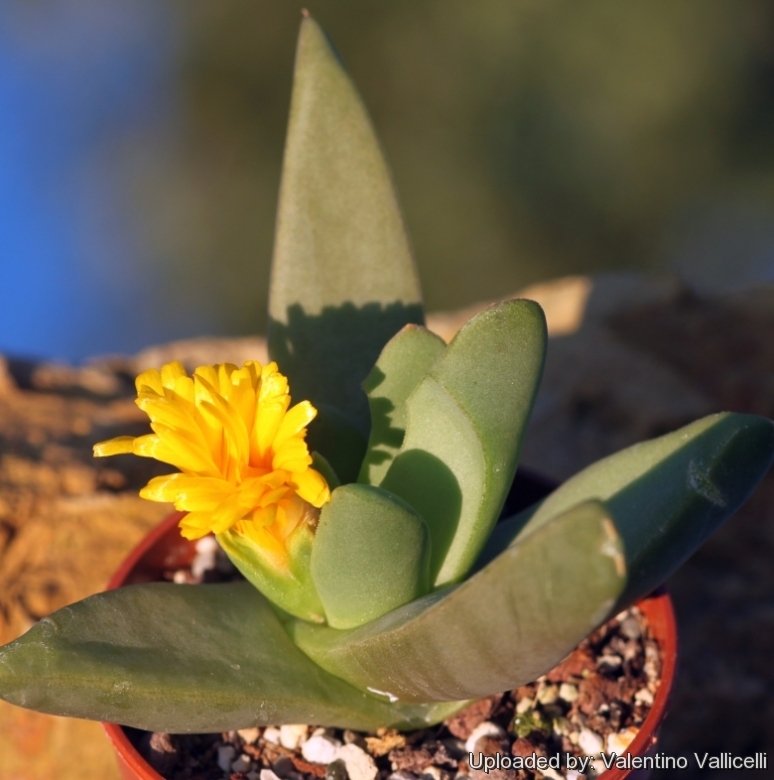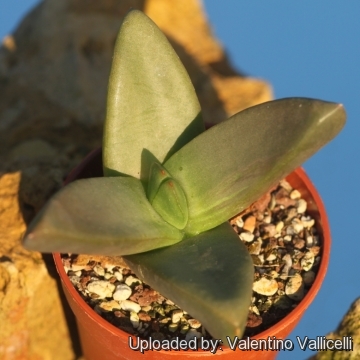Accepted Scientific Name: Glottiphyllum linguiforme (L.) N.E.Br.
Gard. Chron. III, 70: 327 1921

Glottiphyllum latifolium Photo by: Valentino Vallicelli
Origin and Habitat: Ladismith-Distr. Western Cape, South Africa.
Synonyms:
See all synonyms of Glottiphyllum linguiforme
Common Names include:
ENGLISH: Tongue plant
AFRIKAANS (Afrikaans): Tongblaarvygie
Description: Glottiphyllum latifoliumSN|32007]]SN|31207]], is one of the morphological or geographical forms of the curious "tongue plant" botanically known as Glottiphyllum linguiformeSN|31204]]SN|31204]]. Glottiphyllum linguiformeSN|31204]]SN|31204]] is a variable perennial succulent that comprises several questionable varieties and its taxonomic history has undergone several changes. Glottiphyllum latifoliumSN|31207]]SN|31207]] is one of these variety that has short almost stemless shoots with 2-3 pairs of leaves and differences usually concern only the leaves that are not keeled and do not shows any bubble swelling at the base, but this characteristics appear to fall within the natural variation of Glottiphyllum linguiformeSN|31204]]SN|31204]] and it should be synonymized with the latter.
Habit: Plants are caespitose and spread by means of offshoots with short internodes, they forms flat, compact, mats that grows to about 6 cm high with a spread of 30 cm the centre of wich dies off. In their normal, natural state each stem has only 2-3 pairs of leaves at a time though one plant may have several of stems and thus dozens of leaf pairs.
Leaves: Of unequal length, turned edgeways to the sky, 6-8 cm long, 3-4 cm broad, and 8-15 mm thick, the face of both leaves flat or with only a slight impression left by the smaller leaf on the larger one, not keeled on the back and without a pustule (swelling) at the base, both edges somewhat sharp (but not knife-like as in Glottiphyllum linguiformeSN|31204]]SN|31204]]); soft and fleshy, obscurely pellucid-dotted, light-green, becoming prettily suffused with rosy- purple upon exposure to the sun.
Flowers: Sessile or shortly stalked, daisy-like bright yellow 5-7 cm in diameter, often fragrant.
Similar species: This species resemble Glottiphyllum grandiflorumSN|31207]]SN|32007]], N.E.Br., but the swelling at the base and the oblique ridge near the apex of the larger leaf that are both present in G. grandiflorum, are entirely absent from G. latifolium.
Subspecies, varieties, forms and cultivars of plants belonging to the Glottiphyllum linguiforme group
 Glottiphyllum latifolium N.E.Br.: has 2-3 pairs of leaves that are not keeled and do not shows any bubble swelling at the base. Distribution: Ladismith-Distr. Western Cape, South Africa.
Glottiphyllum latifolium N.E.Br.: has 2-3 pairs of leaves that are not keeled and do not shows any bubble swelling at the base. Distribution: Ladismith-Distr. Western Cape, South Africa. Glottiphyllum linguiforme (L.) N.E.Br.: has 2 rows of incurved, strap-shaped, grey-green leaves with rounded tips slightly bent outward. Distribution: Calitzdorp, Oudtshoorn Districts, Western Cape,South Africa.
Glottiphyllum linguiforme (L.) N.E.Br.: has 2 rows of incurved, strap-shaped, grey-green leaves with rounded tips slightly bent outward. Distribution: Calitzdorp, Oudtshoorn Districts, Western Cape,South Africa.
Bibliography: Major references and further lectures
1) Hermann Jacobsen “Handbuch der sukkulenten Pflanzen: Mesembryanthemaceae” G. Fischer, 1955
2) Nicholas Edward Brown, A. Tischer, M. C. Karsten “Mesembryanthema; Descriptions: With Chapters on Cultivation and General Ecology” L. Reeve, 1931
3) Nicholas Edward Brown, A. Tischer, M. C. Karsten “Beschreibungen, Nebst Abhandlungen Über Kultur und Allgemeine Ökologie” L. Reeve, 1931
4) Heidrun E.K. Hartmann “Illustrated Handbook of Succulent Plants: Aizoaceae F-Z” Springer Science & Business Media, 2002
 Glottiphyllum latifolium Photo by: Valentino Vallicelli
Glottiphyllum latifolium Photo by: Valentino VallicelliSend a photo of this plant.The gallery now contains thousands of pictures, however it is possible to do even more. We are, of course, seeking photos of species not yet shown in the gallery but not only that, we are also looking for better pictures than those already present.
Read More... Cultivation and Propagation: The plants in this genus represent some of the more easily cultivated succulent species. Their main growth period is in late winter and were heading for spring-summer dormancy, but they do best with at least a little water all year. Requires little water otherwise their epidermis breaks (resulting in unsightly scars). Water moderately from the middle of summer to the end of winter, and keep the compost almost dry when the plants are dormant. Water minimally in spring and summer, only when the plant starts shrivelling, but they will generally grow even in summer if given water. In areas prone to frost, grow in an intermediate greenhouse or conservatory, in pots of cactus compost, obtainable from good garden centres. Keep cool and shaded in summer, but provide maximum light the rest of the year. Remember that a sunny locality is best, otherwise they will not flower properly. However there are two ways to grow glottiphyllums: The first is to let nature take her course, which means giving them large pots and copious water; they will burgeon into enormous masses of glistening green leaves. The other is to starve them into svelteness by hot summer droughts, small pots, and firm loam. The results can be very attractive. In any case it is best to treat them as late winter growers. Soft leaves mean easy to damage. May be susceptible to mealybugs.
Propagation: Seeds or cuttings. Seeds germinate very easily and can be sown in early to mid-spring, but can be sown at most times of the year (Avoid very hot weather in summer) and germinated in heated humid environment. Do not sow the seeds too deep. If sown too deep, they will be smothered and probably not germinate. Under ideal conditions, seedlings will grow rapidly. Plant the seedlings out when they are 3–5 cm in height.
Alternatively, use stem cuttings taken towards the end of summer in an heated propagating case (15-21°C) Cuttings root easily and remain true to the species, while seeds tend to hybridize.












